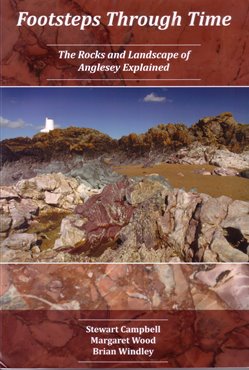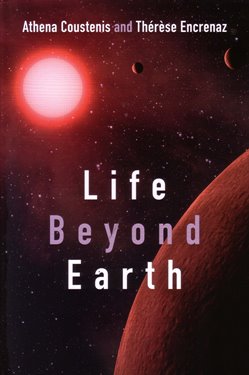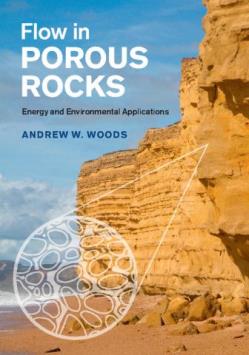 Footsteps through Time: The Rocks and Landscape of Anglesey Explained
Footsteps through Time: The Rocks and Landscape of Anglesey Explained
Anglesey is a geological treasure island with a great variety of rock-types in terms of their origin, metamorphic state and geological age. A wealth of phenomena including pillow lavas, blueschists, ultramafic intrusions, melanges, copper mineralisation and spectacular folding has attracted generations of geology students to the island. In addition, it is the juxtaposition of these contrasting rocks within a small region that has aroused the interests of researchers who seek to explain the present arrangement of units within the context of plate tectonic models. The special features of Anglesey led in 2006 to its designation as a geopark, GeoMôn, belonging to the European and Global Geopark Networks. This book describes 13 Geotrails, geological sites and walks set out for visitors.
Each chapter outlines the geology of rocks of specific stratigraphic age, and deals with the Geotrails exhibited those rocks. In the field, each Geotrail has a poster board or ‘Geoboard’, explaining the salient geological features to seen on the walk. In the book each Geoboard is reproduced in the appropriate chapter together with explanation of the regional context of the rock outcrops.
The book is richly illustrated with photographs, maps and diagrams. Some of the photos benefit from the large (A4) format though this may make it less convenient in the field. The book is ideal for the leaders of groups or individual visitors desiring more background information. There is also a useful introductory section that explains the basics of plate tectonics, a comprehensive glossary of terms and a list of references to relevant publications. The book should attract a large and broad readership.
This is an excellent book and it is therefore difficult to suggest ways that it could have been still better. A map of the island showing the locations of the sites would certainly have been useful. Some of pictures would have benefited from annotation to highlight the key features. I would like to have seen a cross-section or two to clarify the 3D arrangement of rock units.
The aim of the Geomôn geopark, according to the Preface, is to promote geotourism and education. This attractive book with its accessible style of writing and splendid photos of Anglesey’s geological treasures should help achieve that aim.
Reviewed by Richard Lisle
FOOTSTEPS THROUGH TIME: THE ROCKS AND LANDSCAPE OF ANGLESEY EXPLAINED by STEWART CAMPBELL, MARGARET WOOD and BRIAN WINDLEY, 2014. Published by GeoMôn, Isle of Anglesey County Council, 193pp £25.00 http://geomon.co.uk/
 Remote Sensing of Volcanoes and Volcanic Processes
Remote Sensing of Volcanoes and Volcanic Processes
Volcanoes are often remote and inaccessible, particularly after eruption; they have a large footprint and their products are spread widely. Also some are in politically unstable areas (e.g. the Congo), so remote sensing (e.g. from satellites or planes) is very useful. This book focuses on satellite imagery and aerial remote sensing (both with piloted planes and drones).
There is increasing interest in remote sensing of volcanoes. It is telling therefore that the number of remote sensing papers has increased from less than 10 per year in 1990 to over 80 per year now. This book reports a lot of recent studies (particularly the application of InSAR - Interferometric Synthetic Aperture Radar measurements).
The volume contains reviews of several volcanoes and shows how much structural information (e.g. the magma plumbing system) can be inferred remotely. Surface measurements also give information on magma movement below the surface and can show subsidence after the evacuation of the magma chamber. Location of magma pathways and chambers can be inferred from remote sensing data. The book also includes up-to-date advances, from volcanic edifice deformation to thermal anomalies, gas fluxes and the tracking of ash and gas plumes.
Of course, remote sensing is particularly useful for defining the routes of lahars, lava and pyroclastic flows. These can be used in the development of hazard maps. Various authors discuss how various types of model may be used to extract useful information from remote sensing data, to explore the processes underlying the observed signals, to make forecasts to manage hazards.
Predicting eruptions is the holy grail of volcanology. Eruption is often preceded by a period of inflation. Many sub-surface magmatic and volcanic processes cause deformation at the surface. Historically, records of past eruptions have been used to make predictions of future activity. In this book we see how remote sensing can give relatively immediate forecasts of eruptions and how models can be used to enhance prediction. It gives much information on attempts at eruption and explosion prediction, both successful and unsuccessful. It shows that in some places alerts of eruptions in the following month have been very successful.
This book is easy to read and tells all levels of reader much about volcanoes and their internal structure as interpreted from space or the air, and represents good value even at a cover price of £100, let alone the £50 discounted price to Fellows of the Society.
Reviewed by Steve Rowlatt
REMOTE SENSING OF VOLCANOES AND VOLCANIC PROCESSES: INTEGRATING OBSERVATION AND MODELLING by D.M. Pyle (Editor), T.A. Mather (Editor), J Biggs (Editor) Published by the Geological Society London, Special Publication 380. Hardback. ISBN 978-1-86239-362-2 ISBN 0305-8719 Publication Date: Dec 2013 List Price: £100. (Fellows £50) www.geolsoc.org
 Life beyond Earth
Life beyond Earth
Continuing discoveries of ever more extreme environments in which carbon-based, water-reliant life have been found on Earth provide an ever expanding volume of the Habitable Zone (HZ), the distance from a star in which liquid water can exist. The book is organised into an introduction and five sections, each of which becomes more speculative than the last.
The first section, on ‘life as we know it’ and as we may come to know it, wrestles with the fundamental problem of defining what is ‘life’. The authors refuse to exclude novel chemical building blocks such as silanes. But any coherent discussion has to narrow the options to make headway, and so ‘Carbon Chauvinism’ (originally described by Carl Sagan 1973 as a limiting idea) eventually wins through.
‘Water Orthodoxy’ is explained and inevitably accepted, and so later chapters on the prospects for life on the terrestrial planets, and habitable sites in the outer solar system, draw on our greater understanding of the location of liquid water. The authors use the variation over time of the HZ - to areas well outside the traditional Earth-centric orbit – and biotic chemistry to examine the possibilities of early life on Venus (3.5Ga ago) and Mars, within the satellites of the gas giants, and within comets and other trans-Neptunian objects.
The last two chapters would have been inconceivable just two decades ago. The discovery by NASA’s Kepler mission of several thousand candidate planets, of several dozen confirmed extra-solar planets, and the subsequent measurement of the atmospheric composition of such bodies, has given astrobiologists much to consider. The final chapter reads like a science fiction novel, discussing as it does large human habitats in space, terraforming the terrestrial planets and the evolution of our ‘Habitable Zone’ (HZ).
The production of the book is excellent, with black and white illustrations at relevant points in the text, which are then reproduced in full colour in a central section. This neat little volume provides an enjoyable and state-of-the-art review of the search for life outside the traditional HZ. The next generation of space telescopes, and missions such as NASA’s New Horizons and the ESA’s JUICE to the icy moons of Jupiter, will no doubt render some of the content obsolete, but until then it will be of interest to graduate students of planetary geology and philosophers on the meaning of life.
Reviewed by Lewis McCaffrey
LIFE BEYOND EARTH by Athena Coustenis and Thérèse Encrenaz. Cambridge University Press, ISBN 9781107026179, pp 287, List Price: £29.99 W:
http://www.cambridge.org/
 Flow in Porous Rocks
Flow in Porous Rocks
Andrew Woods has researched topics such as groundwater flow, contamination dispersion, oil recovery (primary, secondary and tertiary), underground nuclear waste disposal and geothermal recovery for over 25 years. Now he has shared his experience to introduce the physical processes of such flows through relevant geological formations, supported by a series of analytical models.
The book starts with an exposition of the challenges of modelling flow through porous geological bodies. Such structures are complex but Woods reduces the major features to layers and lenses with faults, sealing and/or non-sealing (leaking), usually arranged heterogeneously. By introducing reasonable assumptions, models that represent the key features which control the flow can be solved analytically to give clear demonstrations of what is going on. Woods' approach is to state the problem, create a model with relevant boundary conditions and then develop the final quantitative analytical solution. The mathematics is indicated but an undergraduate text in fluid mechanics might be needed. Sensitivity to uncertainty of geologic structures is a major challenge for estimating flow rates, so risk assessment and how to quantify are well discussed.
Woods uses these idealised models to elucidate the key controls on a range of systems. Thus applications giving physical insight into the processes are presented in chapters for the motion of oil-water two-phase flow, the stability of displacement fronts and fluid-rock interactions, gravity-driven upward flow movements, particularly the effects of baffles on pollution plumes of contaminants (including NAPL - non-aqueous-phase-liquids) with buoyancy, capillary trapping and dispersion.
Finally, recovery of energy from 'hot' rocks, geo-sequestration of CO2 and shale gas recovery are explored. He discusses the results and presents the information in figures covering key dimensionless variables such as time, flowrate and strata thickness. These results can be applied practically, even informing management decisions. Many of the processes and models have been tested with laboratory experiments giving confidence in the modelling assumptions and analysis, pictures given.
End-of-chapter exercises allow the reader to develop the themes discussed, but solution guides could help. My copy of the book had text black-white figures but many were reproduced in a 30-page insert of coloured versions. Colour certainly highlights clearer many of the key points.
This is a helpful reference with many worked examples for energy systems in geological porous rocks using analytical models. It would assist computer modellers needing to understand/verify their simulation predictions, and graduate students and energy industry professionals needing a clear introduction.
Reviewed by Richard Dawe
FLOW IN POROUS ROCKS: ENERGY AND ENVIRONMENTAL APPLICATIONS by Andrew W Woods. December 2014 Published by Cambridge University Press, 289pp. Hardback ISBN: 9781107065857 List price £70.00. www.cambridge.org/9781107065857